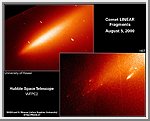|
COMETS EARTH JUPITER KUIPER BELT MARS MERCURY METEORITES NEPTUNE OORT CLOUD PLUTO SATURN SOLAR SYSTEM SPACE SUN URANUS VENUS ORDER PRINTS
PHOTO CATEGORIES SCIENCEVIEWS AMERICAN INDIAN AMPHIBIANS BIRDS BUGS FINE ART FOSSILS THE ISLANDS HISTORICAL PHOTOS MAMMALS OTHER PARKS PLANTS RELIGIOUS REPTILES SCIENCEVIEWS PRINTS
|
Related Document
Download Options
[lower right] In one stunning Hubble picture the fate of the mysteriously vanished solid nucleus of Comet LINEAR has been settled. The Hubble picture shows that the comet nucleus has been reduced to a shower of glowing "mini-comets" resembling the fiery fragments from an exploding aerial firework. This is the first time astronomers have ever gotten a close-up look at what may be the smallest building blocks of cometary nuclei, the icy solid pieces called "cometesimals", which are thought to be less than 100 feet across. The farthest fragment to the left, which is now very faint, may be the remains of the parent nucleus that fragmented into the cluster of smaller pieces to the right. The comet broke apart around July 26, when it made its closest approach to the Sun. The picture was taken with Hubble's Wide Field Planetary Camera 2 on August 5, 2000, when the comet was at a distance of 64 million miles (102 million kilometers) from Earth. Credit: NASA, Harold Weaver (the Johns Hopkins University), and the HST Comet LINEAR Investigation Team
[upper left] Credit: University of Hawaii |
